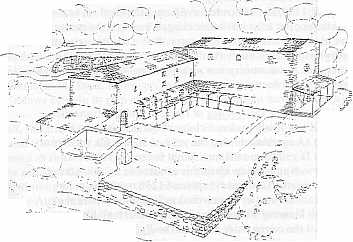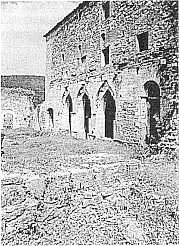Contenuto
Percorso : HOME > English > Pilgrims > RosiaThe hermitage of St. Lucy

Rosia: The hermitage of St. Lucy
The hermitage of St. Lucyá
In the Old Testament book or the prophet Isaiah, we read "If you remove from your midst oppression, false accusation and malicious speech; if you bestow your bread on the hungry and satisfy the afflicted; then the light shall rise for you I the darkness, and the gloom shall become for you like midday; then the Lord will guide you always and give you plenty even on the parched land. He will renew your strength, and you shall be like a watered garden, like a spring whose water flever fails. The ancient ruins shall be rebuilt for your sake, and the foundations from ages past you shall raise up ... " (Isaiah 58: 6-12)
These underlined words, for emphasis, offer an introduction to a presentation regarding the roots and early beginnings of the Augustinian Order. It was in very simple hermitages, now, most of them in ruins, that the foundation of this mendicant order found its beginning. From those hermits, long since dead, and from their dwellings, now in ruins, located in isolated and wooned places in the Tuscan countryside of Italy, a renowned religious community took root. The following five places offer insights to this beginning.
The Constitutions or the Order or St. Augustine being by commenting on the Origin of this religious order in the Church. Among the founders of the religious life, Saint Augustine "distinguished member of the Lord's body" that he was, has acquired an eminent position. After his conversion, setting aside "with the utmost determination all hope that he had of a career in the world, and deciding to serve God together with his friends, he returned to Africa. There, first at Thagaste as a layman, and then, after he became a priest, at Hippo, he soon introduced the religious life "ilt keeping with the manner and rule conceived under the holy apostles." As "the ideals, the chastity, and the profound sense of poverty of the servants of God became better known, this way of life produced many brothers who would be ordained clerics for the service of the Church.
On this firm foundation established by Saint Augustine, especially as found in his Rule, the Holy See, in the thirteenth century, promoted the founding of our Order from the union and development of various groups of hermits, and destined it with wise provision for the service of the Church among the orders of evangelical poverty, or of apostolic fraternity, as they are called. On 9 April 1256, the Order was confirmed under the name of "Order of Hermits of St. Augustine. "
The title of hermits gradually became synonymous with that of Augustinians. Hence our Order is fittingly called the "Order of Brothers of Saint Augustine: and is designated by the initials O.S.A. This title may be correctly rendered in shorter form as the "Order o Saint Augustine" or the "Augustinian Order."
(The Constitutions or the Order or St. Augustine, 1: 3 - 5)

Rosia: the church of St. Lucy
In the next section on the Nature of the order, a further description of the Augustinians is noted. The elements that flowed together to form the Order were fused in such a way that the Order became both Augustinian and apostolic. ln the Order, religious profession, by which we consecrate ourselves to God, was regarded as the basis and principle of all our sharing of life and our fraternal equality. The Order 's essential characteristics were then, both the heritage "of a religious family founded by Saint Augustine" and the fundamental principles of the orders of apostolic fraternity .... Our Order is one of apostolic fraternity, that is a community of brothers who live with the people of God, offering them the example in the witness of charity and evangelical poverty and presenting sound doctrine. (The Constitutions of the Order of St. Augustine, 1: 7 and 10)
Approximately eighteen miles southwest of Siena, some twenty-five miles from San Gimignano and not too distant from Lecceto, along the road leading southwest to the coast of the Tyrrhenian Sea, one's attention is suddenly taken up by an ancient, single-arched bridge on the left. Here, the visit to the hermitage of Santa Lucia begins. Crossing this Roman bridge over the Rosia river and following the remains of a cobblestone, Roman road, one makes bis way through the woods to the ruins of this old, medieval Augustinian site which helps to appreciate the roots or origins of the Augustinian Order. During the Middle Ages, this road was a pilgrim's route to Rome beginning up among the Alpine passes.
The hermitage was situated just a little off the road but close enough to be visited by pilgrirns. It cut into the hillside and consisted of a Gothic church, the hermit's convento or friary, places for working and storage, a cloister roofed over on tow sides and a canal for bringing fresh water to the residente. The hermits/friars always took two things into consideration when they built hermitages and then friaries: access to the road to welcome pilgrims and guests and access to water, a necessity for living.á á
Santa Lucia was part of the collection of early communities that were already in existence at the time of the formation of the Order beginning in 1244 with what is called 'the Little Union'. It was begun by a hermit names Bonacorso somewhere around the year 1170, but seems to have been inhabited several centuries before. There is evidence of at least one other church beneath the present one. Tombs were found there, dating from the tenth century, and walls underneath the house indicate ninth century origins. We know that Bonacorso soon attracted a number of followers because a community was already flourishing by 1200 when it is mentioned in written documents. Like the legends of Lecceto and Centumcelle, Rosia makes a claim about a visit from St. Augustine during the year of 387 on his way from Milan to Rome.
What is certain is that its Augustinian history is attested to by the Acts of the Generai Chapter of 1250, when its prior, Domenic, was elected as Econome General or General Treasurer of the Order. In all likelihood, the community adopted the Rule of St. Augustine in 1244 at the moment of the unification of the hermitages of Tuscany. Also, like Lecceto, Rosia had its Blessed, saintly friars, whose popolar cults gave rise to a number of legends. We know the names of four of them: Rinero, Gualfredo, Pietro de Rossi, and Giacomo. Pietro was renowned for his devotion to the cross and the gift of tears when contemplating the pains of Christ. Giacomo was a lay brother who dedicated himself to the poor and the sick and who succeeded in having an apple tree produce twice a year. It is said that Blessed Augustine Novello, a well known friar in nearby Siena, lived bere for a while. He had entered the Order after a career as a lawyer in the court of King Manfred in Sicily.
After Manfred's death on the battlefield, he fled Sicily and became an Augustinian lay brother, keeping his real identity and talents hidden. The prior of Rosia discovered who he was and passed the news to Rome. The Prior General ordered Augustine to become an ordained priest and to lend his assistance to the whole Order. He was one of the principal collaborators in the composition of the first Constitutions of the Order of St. Augustine decreed in Ratisbon, Germany, in 1290. This clearly indicates how rapidly the order spread through Europe in a very brief time. Blessed Augustine Novello was also Prior General for a time but he resigned the post in mid-term to retire to another Tuscany convento, that of San Leonardo di Lago, located a shore distance from Lecceto. Still another important name is associated with Rosia, Blessed Clement of Osimo, known as the greatest of the Prior Generals in the formative period of the Order. During his many travels to weld the heterogeneous elements out of which theáOrder had been formed by the Grand Union of 1256 into a body one in spirit and action as well as outward appearance, Santo Lucia of Rosia is mentioned as one of the communities he visited. All that is found of the hermitage today is ruins. The church still reflects its elegant simplicity, another hallmark of Augustinian life, in the one standing wall of alternating white and red marble in the Pisa-Lucchese style.
The convento has been much transformed during the years it functioned as a farmhouse. Now for years, completely abandoned, its most interesting pieces were taken away and place in the home of the owner of the land. However, three gothic arches and the traces of a number of windows remain to give evidence of what it might have looked like. In 1969, the site was excavated by Wayne State and Northern Kentucky Universities and the Tuscan American and Etruscan Foundations. At this time, two coins were found at the level of the second church, one from Henry II of Germany (1002) and the other of Guido Tarlato, the archbishop of Arezzo (shortly after).
These are a testimony to the antiquity of eremitical presence. Material relating to the origins of the Augustinian Order has recently begun to be systematically collected and sifted. The principal difficulties arise from the graduai development of the Order's pre-history as well as the mass of legend that surrounds it. Much more remains to be done.

